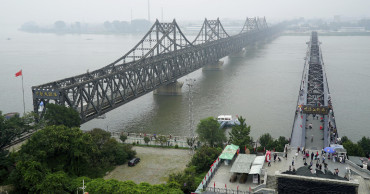N Korea
G-7 envoys urge tough stance on Chinese, N Korean aggression
Top diplomats from the Group of Seven wealthy democracies are tackling two major worries in Northeast Asia, vowing a tough stance on China’s increasing threats to Taiwan and North Korea's unchecked tests of long-range missiles.
Another major crisis, Russia’s war in Ukraine, will also consume the agenda Monday as the diplomats gather in this Japanese hot spring resort town for Day Two of talks meant to pave the way for action by G-7 leaders when they meet next month in Hiroshima.
For the American delegation, the meeting comes at a crucial moment in the world’s response to Russia’s invasion of Ukraine and efforts to deal with China, two issues that G-7 ministers from Japan, the United States, the United Kingdom, France, Germany, Canada, Italy and the European Union regard as potent challenges to the post-World War II rules-based international order.
Also Read: G7 vows to step up moves to renewable energy, zero carbon
A senior U.S. official traveling with U.S. Secretary of State Antony Blinken told reporters that the Biden administration’s goal for the talks is to shore up support for Ukraine, including a major initiative on Ukraine’s energy infrastructure launched at last year’s G-7 gatherings in Germany, as well as to ensure the continued provision of military assistance to Kyiv. Ramping up punishment against Russia for the conflict, particularly through economic and financial sanctions that were first threatened by the G-7 in December 2021, before the invasion, will also be a priority, the official said.
Ukraine faces an important moment in coming weeks with Russia’s current offensive largely stalled and Ukraine preparing a counter-offensive. The U.S. official, who spoke on condition of anonymity to discuss Blinken’s priorities at the closed-door meetings, said there would be discussion about ways to deepen support for Ukraine’s long-term defense and deterrence capabilities. That might also improve Kyiv’s position for potential negotiations that could end the conflict on its terms.
The role of Japan — the only Asian member of the G-7 — as chairman of this year's talks provides an opportunity to discuss coordinated action on China. Leaders and foreign ministers of G-7 countries, most recently France and Germany, have recently concluded visits to China, and the diplomats in Karuizawa are expected to discuss their impressions of where the Chinese stand on numerous issues, including the war in Ukraine, North Korea, and Taiwan, which is a particular sore point in U.S.-Chinese relations.
At a private working dinner on Sunday night that marked the diplomats’ first formal meeting, Japanese Foreign Minister Yoshimasa Hayashi urged continued dialogue with China on the many global challenges where participation from Beijing is seen as crucial. Among the Chinese interests that are intertwined with those of wealthy democracies are global trade, finance and climate efforts.
But the diplomats are also looking to address China’s more aggressive recent stance in Northeast Asia, where it has threatened Taiwan, the self-governing democracy that Beijing claims as its own.
Hayashi told ministers that outside nations must continue “building a constructive and stable relationship, while also directly expressing our concerns and calling for China to act as a responsible member of the international community,” according to a summary of the closed-door dinner.
China recently sent planes and ships to simulate an encirclement of Taiwan. Beijing has also been rapidly adding nuclear warheads, taking a tougher line on its claim to the South China Sea and painting a scenario of impending confrontation.
The worry in Japan can be seen it its efforts in recent years to make a major break from its self-defense-only post-WWII principles, working to acquire preemptive strike capabilities and cruise missiles to counter growing threats.
Blinken, the top U.S. diplomat, had been due to visit Beijing in February, but the trip was postponed because of a Chinese spy balloon incident over U.S. airspace and has yet to be rescheduled.
Blinken met briefly with China’s top diplomat, Wang Yi, on the sidelines of the Munich Security Forum, but high-level contacts between Washington and Beijing have become rare. Thus, Blinken will be seeking insight from his French and German counterparts on their interactions with the Chinese, the senior U.S. official said.
Despite indications, notably comments from French President Emmanuel Macron, that the G-7 is split over China, the official said there is shared worry among G-7 nations over China’s actions. The official added that the foreign ministers would be discussing how to continue a coordinated approach to China.
North Korea is also a key area of worry for Japan and other neighbors in the region.
Since last year, Pyongyang has test-fired around 100 missiles, including intercontinental ballistic missiles that showed the potential of reaching the U.S. mainland and a variety of other shorter-range weapons that threaten South Korea and Japan.
Hayashi “expressed grave concern over North Korea’s launch of ballistic missiles with an unprecedented frequency and in unprecedented manners, including the launch in the previous week, and the G-7 Foreign Ministers strongly condemned North Korea’s repeated launches of ballistic missiles,” according to the summary.
2 years ago
Seoul-Tokyo ties key to address N Korea, supply chains
South Korea’s president wants to quickly overcome decades of lingering hostility left over from Japan’s past colonial rule of the Korean Peninsula and forge a united front to meet regional security and economic challenges facing the neighbors.
“We cannot afford to waste time while leaving strained Korea-Japan relations unattended,” President Yoon Suk Yeol said in written response to questions posed by several foreign media outlets including The Associated Press. “I believe we must end the vicious cycle of mutual hostility and work together to seek our two countries’ common interests.”
Yoon’s comments were provided Wednesday, a day before he travels to Tokyo for a closely watched summit with Japanese Prime Minister Fumio Kishida. The focus of attention is whether and what corresponding steps Kishida would take in response to Yoon’s recent plans to use South Korean funds to compensate some of the colonial-era Korean forced laborers without requiring Japanese contributions.
Yoon’s push has triggered criticism from some victims and his domestic political rivals, who have called for direct compensation from Japanese companies that employed the forced laborers. But Yoon has defended his decision, saying greater ties with Japan is essential to tackle a slew of foreign policy and economic challenges.
Also Read: Japan, S. Korea summit must overcome history to renew ties
“There is an increasing need for Korea and Japan to cooperate in this time of a poly-crisis with North Korean nuclear and missile threats escalating and global supply chains being disrupted,” Yoon said. “I am confident that the Japanese government will join us in opening a new chapter of Korea-Japan relations which will go down to history.”
Addressing Yoon’s comments, Japanese Chief Cabinet Secretary Hirokazu Matsuno said later Wednesday that Tokyo seeks to strengthen “strategic cooperation” with South Korea as well as trilaterally with the United States. He said he hopes that there will be “open-hearted exchanges” between the leaders of the two countries.
South Korea and Japan, both key U.S. allies and vibrant democracies, are closely linked to each other economically and culturally. But their ties plunged to one of their lowest points in decades after South Korea’s Supreme Court in 2018 ordered two Japanese companies — Nippon Steel and Mitsubishi Heavy Industries — to compensate some of their former Korean employees for forced labor during the 1910-45 colonial rule.
Japan has insisted all compensation issues were already settled by a 1965 treaty that normalized bilateral ties and was accompanied by $800 million in economic aid and loan from Tokyo to Seoul. The history disputes spilled over to other issues, with Tokyo placing export controls and South Korea threatening to terminate a military intelligence-sharing pact.
Also Read: North Korea launches 2 missiles to sea as allies hold drills
The feuding undermined a U.S. push to reinforce its alliances in Asia to better cope with North Korean nuclear threats and a Chinese rise.
Since taking office last May, Yoon, a conservative, has been focusing on repairing ties with Japan, boosting the military alliance with the United States and building a stronger trilateral Seoul-Washington-Tokyo security cooperation. Yoon says those steps were needed to deter North Korea, whose nuclear-capable missiles put both South Korea and Japan within striking distance.
Tensions with North Korea have further intensified recently, with the North test-firing a spate of missiles in protest of the South Korean-U.S. military drills that it views as an invasion rehearsal.
“As North Korea’s nuclear development seriously threatens peace and security on the Korean Peninsula and beyond, it is more important than ever that the international community works on a concerted deterrence and responses – this includes the ROK-U.S. alliance and ROK-U.S.-Japan security cooperation,” Yoon said, invoking South Korea’s formal name.
After Yoon’s government announced it would use money raised domestically to compensate the former forced laborers who won damages in the 2018 rulings, U.S. President Joe Biden hailed the plan as a major step toward enhancing the partnership between two of Washington’s closest allies.
While experts say that North Korea’s aggressive weapons testing activities are aimed forcing the United States to accept it as a nuclear power and relaxing international sanctions, Yoon said Kim would fail to achieve this goal.
“Since the complete denuclearization of North Korea is the clear and unchanging goal of the international community, the Republic of Korea will never acknowledge North Korea as a nuclear state under any circumstances,” Yoon said.
He said Seoul, Washington and Tokyo are “continuously taking strong diplomatic, economic and military measures to show that the international community’s commitment to denuclearizing North Korea is stronger than North Korea’s commitment to the development of nuclear weapons.”
Yoon also called on North Korea to halt its “reckless” nuclear program and take steps to address the suffering of its people. He said South Korea is willing to provide humanitarian assistance to North Korean people, citing an assessment “that food shortages there have grown worse with some regions seeing people dying of hunger recently.”
Yoon expressed optimism that the thawing of diplomatic relations between South Korea and Japan would also expand economic cooperation between the technology-driven countries, which he said would be crucial to address industrial supply chain vulnerabilities and other global challenges.
“If Korea-Japan relations are normalized, I expect to see acceleration of strategic cooperation, such as technological partnerships, joint research & development and the expansion of mutual investments in various fields, such as semiconductors, space and bio-health including materials, parts and equipment," he said.
Yoon said expanded cooperation between South Korea and Japan – both semiconductor powerhouses – will contribute “greatly” in improving the resilience in global supply chains, which have been rattled by Russia’s invasion of Ukraine and COVID-19 and could be reshaped by an intensifying U.S.-China rivalry.
Yoon also said South Korea and Japan while pursuing stronger bilateral ties should also seek to advance their economic relations with China in a “stable manner.”
A government-affiliated foundation in South Korea will likely handle reparations to forced labor victims with money contributed by steel giant POSCO and other local companies that benefited from the 1965 accord. POSCO said Wednesday that it decided to newly contribute 4 billion won ($3 million) to the foundation in addition to the 6 billion won ($4.6 million) that it has previously contributed to the foundation.
South Korean officials say they don't expect Nippon Steel or Mitsubishi to immediately contribute to the South Korean funds for the forced labor victims. They say they expect the Japanese companies to participate in a separate possible fund aimed at facilitating cultural exchanges and other cooperation between the two countries.
2 years ago
N Korea calls UN chief's remarks on missile test 'unfair'
North Korea on Wednesday accused U.N. Secretary-General Antonio Guterres of “an extremely unfair and imbalanced attitude,” as it lambasted him for condemning its recent missile test but ignoring alleged U.S. hostility against the North.
After the North’s intercontinental ballistic missile test on Saturday, Guterres strongly condemned the launch and reiterated his call for the North to immediately desist from making any further provocations. In a statement, Guterres also urged North Korea to resume talks on denuclearization of the Korean Peninsula.
“To be most deplorable, the U.N. secretary-general is going on the rampage of illogical and miserable remarks, which are little different from those of U.S. State Department officials over the years,” Kim Son Gyong, the North’s vice foreign minister for international bodies, said in a statement carried by state media.
Kim said North Korea’s ICBM test was a response to the security threat the U.S. posed to the North by temporarily deploying long-range bombers for joint training with South Korea earlier this year. Kim said the test was also a warning to the earlier convocation of the U.N. Security Council on the North.
North Korea views U.S.-South Korea military drills as an invasion rehearsal and is particularly sensitive to the U.S. mobilization of B-1B bombers that can carry a massive conventional payload of both guided and unguided weapons. After the North’s ICBM test, the United States flew B-1B bombers again for separate drills with South Korean and Japanese warplanes.
Read more: US urges UN to condemn North Korea; China, Russia blame US
“The U.N. secretary-general should clearly understand that his unreasonable and prejudiced stand on the Korean Peninsula issue is acting as a factor inciting the hostile acts of the U.S. and its followers against (North Korea),” Kim said.
Last November, North Korean Foreign Minister Choe Son Hui called Guterres “a puppet of the United States” for condemning an earlier ICBM test by the North.
Saturday’s ICBM test, the North’s first missile test since Jan. 1, was made on a steep angle to avoid neighboring countries. The reported launch details again suggested the North has missiles that can reach the U.S. mainland. But many foreign experts say the North still must develop some last remaining technologies to acquire functioning nuclear-tipped missiles, such as one shielding missiles from the harsh conditions during atmospheric reentry.
In response to the latest U.S. deployment of B1-B bombers on Sunday, North Korea said its 600-millimeter multiple rocket launcher fired two rounds off its east coast the next day. North Korea has said its rockets can carry nuclear warheads. South Korea views the weapons as a short-range ballistic missile.
South Korea and the United States are to hold a set of joint military drills in coming weeks, including a table-top exercise set to take place at the Pentagon on Wednesday.
Last year, North Korea test-launched more than 70 missiles, the most ever in a single year, as part of its efforts to enlarge its weapons arsenal. Observers say the North would eventually want to win international recognition as a legitimate nuclear state and use that status as a way to get U.N. and other international sanctions on it lifted.
2 years ago
N Korea fires 2 ballistic missiles in resumption of testing
North Korea fired a pair of ballistic missiles on Sunday toward its eastern waters, its first weapons test in a month and coming two days after it claimed to have performed a key test needed to build a more mobile, powerful intercontinental ballistic missile designed to strike the U.S. mainland.
South Korea’s military detected the launch of two North Korean ballistic missiles from its northwest Tongchangri area. The missiles flew across the country toward its eastern waters, South Korea’s Joint Chiefs of Staff said in a statement.
It said the missiles were fired about 50 minutes apart but gave no further details, like precisely what type of weapons North Korea fired and how far they flew. The Joint Chiefs of Staff said South Korea’s military has bolstered its surveillance posture and maintains a readiness in close coordination with the United States.
Read more: Missile tests practiced to attack South, US: North Korea
Japanese officials also said they spotted the two missile launches from North Korea. Its coast guard said the missiles fired from North Korea fell in the waters between the Korean Peninsula and Japan. Japanese coast guard officials said both missiles landed outside Japan’s exclusive economic zone.
The Tongchangri area is home to North Korea’s Sohae Satellite Launching Ground, where the country in past years launched satellite-carrying long-range rockets in what the U.N. called a disguised test of ICBM technology.
On Thursday, in the Sohae facility, North Korea also performed what it called the test of a “high-thrust solid-fuel motor” for a new strategic weapon, a development that experts say could allow it to possess a more mobile, harder-to-detect arsenal of intercontinental ballistic missiles that can reach the U.S. mainland.
It wasn’t immediately known if Sunday’s launches occurred from the Sohae facility.
Sunday’s launch is the North’s first public weapons test since the country last month launched its developmental, longest-range liquid-fueled Hwasong-17 ICBM capable of reaching the entire U.S. homeland. Earlier this year, North Korea test-launched a variety of other missiles at a record pace, despite pandemic-related economic hardships and U.S.-led pressures to curb its nuclear program.
Read more: North Korea continues its bombardment of missiles with a potential ICBM
North Korea has defended its weapons testing as self-defense measures to cope with the expanded U.S.-South Korea military drills that it views as an invasion rehearsal. But some experts say North Korea likely used its rivals’ military training as an excuse to enlarge its weapons arsenal and increase its leverage in future negotiations with the U.S.
The weapon North Korea said it could build with the recently tested motor likely refers to a solid-fueled ICBM, which is among a list of high-tech weapons systems that leader Kim Jong Un vowed to procure during a major ruling Workers’ Party conference early last year. Other weapons systems Kim promised to manufacture include a multi-warhead missile, underwater-launched nuclear missiles and spy satellites.
The fuel in solid-propellant rockets is already loaded inside, which helps to shorten launch preparation times, increase the weapon’s mobility and make it harder for outsiders to detect what’s happening before liftoff. North Korea already has a growing arsenal of short-range, solid-fueled ballistic missiles targeting key locations in South Korea, including U.S. military bases there.
The exact status of North Korea’s nuclear attack capability remains in secrecy, as all its intercontinental ballistic missile tests in recent years have been carried out at a steep angle to avoid neighboring countries.
Some experts speculate North Korea already has functioning nuclear-tipped missiles that can hit the entire U.S., given the number of years it has spent on its nuclear program. But others say country is still years away from acquiring such weapons, saying it has yet to publicly prove it has a technology to protect warheads from the harsh conditions of atmospheric reentry.
3 years ago
N Korea fires 23 missiles, prompting air raid alert in South
Air raid sirens sounded on a South Korean island and residents evacuated to underground shelters after North Korea fired more than 20 missiles Wednesday, at least one of them in its direction and landing near the rivals’ tense sea border. South Korea quickly responded by launching its own missiles in the same border area.
The launches came hours after North Korea threatened to use nuclear weapons to get the U.S. and South Korea to “pay the most horrible price in history” in protest of ongoing South Korean-U.S. military drills that it views as an invasion rehearsal. The White House maintained that the United States has no hostile intent toward North Korea and vowed to work with allies to curb North Korea’s nuclear ambitions.
The North’s barrage of missile tests also came as world attention was focused on South Korea following a weekend Halloween tragedy that saw more than 150 people killed in a crowd surge in Seoul in what was the country’s largest disaster in years.
Read more:North Korea fires ballistic missile toward sea: Seoul officials
South Korea’s military said North Korea launched at least 23 missiles — 17 in the morning and six in the afternoon — off its its eastern and western coasts on Wednesday. It said the weapons were all short-range ballistic missiles or suspected surface-to-air missiles. Also Wednesday, North Korea fired about 100 artillery shells into an eastern maritime buffer zone the Koreas created in 2018 to reduce tensions, according to South Korea’s military.
The 23 missiles launched is a record number of daily missile tests by North Korea, some experts say.
One of the ballistic missiles was flying toward South Korea’s Ulleung island before it eventually landed 167 kilometers (104 miles) northwest of the island. South Korea’s military issued an air raid alert on the island, according to the South’s Joint Chiefs of Staff. South Korean media published photos of island residents moving to underground shelters.
Hours later, South Korea’s military said it lifted the air raid alert on the island. South Korea’s transport ministry said it has closed some air routes above the country’s eastern waters until Thursday morning in the wake of the North Korean launches.
That missile landed 26 kilometers (16 miles) away from the rivals’ sea border. It landed in international waters off the east coast of South Korea. South Korea’s military said it was the first time a North Korean missile has landed so close to the sea border since the countries’ division in 1948.
“This is very unprecedented and we will never tolerate it,” the Joint Chiefs of Staff said in a statement.
In 2010, North Korea shelled a front-line South Korean island off the peninsula’s western coast, killing four people. But the weapons used were artillery rockets, not ballistic missiles whose launches or tests are banned by multiple U.N. Security Council resolutions.
Later Wednesday, South Korean fighter jets launched three air-to-surface, precision-guided missiles near the eastern sea border to show its determination to get tough on North Korean provocations. South Korea’s military said the missiles landed in international waters at the same distance of 26 kilometers (16 miles) north of the sea border as the North Korean missile fell earlier Wednesday.
It said it maintains a readiness to win “an overwhelming victory” against North Korea in potential clashes.
“North Korea firing missiles in a way that sets off air raid sirens appears intended to threaten South Koreans to pressure their government to change policy,” said Leif-Eric Easley, a professor at Ewha University in Seoul. “North Korea’s expanding military capabilities and tests are worrisome, but offering concessions about alliance cooperation or nuclear recognition would make matters worse.”
The Joint Chiefs of Staff earlier identified three of the North Korean weapons launched as “short-range ballistic missiles” fired from the North’s eastern coastal town of Wonsan, including the one that landed near the sea border.
North Korean short-range weapons are designed to strike key facilities in South Korea, including U.S. military bases there.
In an emergency meeting with top security officials, South Korean President Yoon Suk Yeol ordered officials to take swift unspecified steps to make North Korea face consequences for its provocation. He said he would consider the North Korean missile’s landing near the border “a virtual violation of (our) territorial waters.”
Read more:N. Korea flies warplanes near border, firing another missile
During the meeting, officials also lamented that the North Korean missile launches came as South Korea is in a mourning period over the crowd crush. They noted this “clearly showed the nature of the North Korean government,” according to South Korea’s presidential office.
Earlier Wednesday, Japanese Defense Minister Yasukazu Hamada said at least two ballistic missiles fired by North Korea showed a possibly “irregular” trajectory. This suggests the missiles were the North’s highly maneuverable, nuclear-capable KN-23 missile, which was modeled on Russia’s Iskander missile.
Japanese Prime Minister Fumio Kishida called North Korea’s continuing missile tests “absolutely impermissible.”
Analyst Cheong Seong-Chang at the private Sejong Institute in South Korea said the danger of armed clashes between the Koreas off their western or eastern coasts is increasing. He said South Korea needs to make “proportional responses” to North Korean provocations, not “overwhelming responses,” to prevent tensions from spiraling out of control and possibly leading the North to use its tactical nuclear weapons.
Animosities on the Korean Peninsula have been running high in recent months, with North Korea testing a string of nuclear-capable missiles and adopting a law authorizing the preemptive use of its nuclear weapons in a broad range of situations. Some experts still doubt North Korea would use nuclear weapons first in the face of U.S. and South Korean forces.
North Korea has argued its recent weapons tests were meant to issue a warning to Washington and Seoul over their joint military drills that it views as an invasion rehearsal, including this week’s exercises.
In a statement released early Wednesday, Pak Jong Chon, a secretary of the ruling Workers’ Party who is considered a close confidant of leader Kim Jong Un, called the Vigilant Storm air force drills “aggressive and provocative.”
“If the U.S. and South Korea attempt to use armed forces against (North Korea) without any fear, the special means of the (North’s) armed forces will carry out their strategic mission without delay,” Pak said, in an apparent reference to his country’s nuclear weapons.
“The U.S. and South Korea will have to face a terrible case and pay the most horrible price in history,” he said.
U.S. and South Korean officials have steadfastly said their drills are defensive in nature and that they have no intentions of attacking North Korea.
“We reject the notion that they serve as any sort of provocation. We have made clear that we have no hostile intent towards (North Korea) and call on them to engage in serious and sustained diplomacy,” White House National Security Council spokesperson Adrienne Watson said late Tuesday.
North Korea “continues to not respond. At the same time, we will continue to work closely with our allies and partners to limit the North’s ability to advance its unlawful weapons programs and threaten regional stability,” Watson said.
This year’s Vigilant Storm military exercises are the largest-ever for the annual fall maneuvers, the U.S. Indo-Pacific Command said. About 1,600 flights are planned involving 240 U.S. and South Korean fighter jets. The round-the-clock drills, which began Oct. 31, are to continue through Nov. 4 and include warfighting tactics both in the air and on the ground, it said.
3 years ago
N Korea warns of security instability over US-S Korea drills
North Korea has warned that the United States and South Korea will face “unprecedented” security challenges if they don’t stop their hostile military pressure campaign against the North, including joint military drills.
North Korea views any regular U.S.-South Korean military training as an invasion rehearsal even though the allies have steadfastly said they have no intention of attacking the North. The latest warning came as Washington and Seoul prepare to expand their upcoming summertime training following the North’s provocative run of missile tests this year.
“Should the U.S. and its allies opt for military confrontation with us, they would be faced with unprecedented instability security-wise,” Choe Jin, deputy director general of the Institute of Disarmament and Peace, a Foreign Ministry-run think tank, told Associated Press Television News in Pyongyang on Thursday.
Choe said that Washington and Seoul’s joint military drills this year are driving the Korean Peninsula to the brink of war. He accused U.S. and South Korean officials of plotting to discuss the deployment of U.S. nuclear strategic assets during another joint drill set to begin next month.
“The U.S. should keep in mind that it will be treated on a footing of equality when it threatens us with nukes,” Choe said. He said Washington must abandon “its anachronistic and suicidal policy of hostility” toward North Korea or it will face “an undesirable consequence.”
Read: UN court to rule on jurisdiction in Rohingya genocide case
The regular U.S.-South Korea military drills are a major source of animosity on the Korean Peninsula, with North Korea often responding with missile tests or warlike rhetoric.
In May, U.S. President Joe Biden and new South Korean President Yoon Suk Yeol said after their summit that they would consider expanded joint military exercises to deter North Korean nuclear threats. Biden also reaffirmed the American extended deterrence commitment to South Korea, a reference to a full range of U.S. defense capabilities including nuclear ones.
Their announcement reflected a change in direction from that of their predecessors. Former U.S. President Donald Trump complained about the cost of the U.S.-South Korean military drills, while former South Korean President Moon Jae-in faced criticism that his dovish engagement policy only helped North Korea buy time to perfect its weapons technology. Yoon accused Moon of tilting toward North Korea and away from the United States.
The U.S. and South Korean militaries haven’t officially announced details about their summertime drills including exactly when they would start. But South Korean defense officials said the drills would involve field training for the first time since 2018 along with the existing computer-simulated tabletop exercises.
In recent years, the South Korean and U.S. militaries have cancelled or downsized some of their regular exercises due to concerns about COVID-19 and to support now-stalled U.S.-led diplomacy aimed at convincing North Korea to give up its nuclear program in return for economic and political benefits.
3 years ago
N. Korea reports 6 deaths after admitting COVID-19 outbreak
North Korea said Friday that six people died and 350,000 have been treated for a fever that has spread “explosively” across the nation, a day after its first acknowledgement of a COVID-19 outbreak.
The true scale is unclear, but a big COVID-19 outbreak could be devastating in a country with a broken health care system and an unvaccinated, malnourished population. North Korea, which likely doesn’t have sufficient COVID-19 tests and other medical equipment, said it didn't know the case of the mass fevers.
The North’s official Korean Central News Agency said of the 350,000 people who developed fevers since late April, 162,200 have recovered. It said 18,000 people were newly found with fever symptoms on Thursday alone, and 187,800 people are being isolated for treatment.
One of the six people who died was confirmed infected with the omicron variant, KCNA said, but it wasn’t immediately clear how many of the total illnesses were COVID-19.
Also read: North Korea confirms 1st COVID outbreak, Kim orders lockdown
North Korea imposed a nationwide lockdown Thursday after acknowledging a COVID-19 outbreak for the first time in the pandemic. Those reports said tests from an unspecified number of people came back positive for the omicron variant.
It’s possible that the spread of the virus was accelerated by a massive military parade in Pyongyang on April 25, where North Korean leader Kim Jong Un took center stage and showcased the most powerful missiles of his military nuclear program in front of tens of thousands.
Cheong Seong-Chang, an analyst at South Korea’s Sejong Institute, said the pace of the fever's spread suggests the crisis could last months and possibly into 2023, causing major disruption in the poorly equipped country.
Some experts say the North’s initial announcement communicates a willingness to receive outside aid. It previously shunned vaccines offered by the U.N.-backed COVAX distribution program, possibly because they have international monitoring requirements.
South Korea’s Unification Ministry, which handles inter-Korean affairs, said the South was willing to provide medical assistance and other help to North Korea based on humanitarian considerations.
KCNA said Kim was briefed about the fever when he visited the emergency epidemic prevention headquarters on Thursday and criticized officials for failing to prevent “a vulnerable point in the epidemic prevention system.”
He said the spread of the fever has been centered around capital Pyongyang and nearby areas and underscored the importance of isolating all work, production and residential units from one another while providing residents with every convenience during the lockdown.
“It is the most important challenge and supreme tasks facing our party to reverse the immediate public health crisis situation at an early date, restore the stability of epidemic prevention and protect the health and wellbeing of our people,” KCNA quoted Kim as saying.
North Korea's claim of a perfect record in keeping out the virus for two and a half years was widely doubted. But South Korean officials have said North Korea had likely avoided a huge outbreak until now, in part because it instituted strict virus controls almost from the start of the pandemic.
Also read: North Korea raises alarm after confirming 1st COVID-19 case
Describing its anti-coronavirus campaign as a matter of “national existence,” North Korea had severely restricted cross-border traffic and trade and is even believed to have ordered troops to shoot on sight any trespassers who cross its borders.
The border closures further battered an economy already damaged by decades of mismanagement and crippling U.S.-led sanctions over its nuclear weapons and missile program, pushing Kim to perhaps the toughest moment of his rule since he took power in 2011.
Hours after confirming the outbreak Thursday, North Korea launched three short-range ballistic missiles toward the sea, South Korea and Japan said, in what possibly was a show of strength after Kim publicly acknowledged the virus outbreak. It was the North’s 16th round of missile launches this year.
White House press secretary Jen Psaki said the United States supported international aid efforts but doesn’t plan to share its vaccine supplies with the North.
“We do continue to support international efforts aimed at the provision of critical humanitarian aid to the most vulnerable North Koreans, and this is, of course, a broader part of the DPRK continuing to exploit its own citizens by not accepting this type of aid,” Psaki said Thursday in Washington, referring to North Korea by its formal name, the Democratic People’s Republic of Korea.
“It’s not just vaccines. It’s also a range of humanitarian assistance that could very much help the people and the country and instead they divert resources to build their unlawful nuclear and ballistic missiles programs.”
3 years ago
North Korea fires ballistic missile into sea in latest test
North Korea fired a ballistic missile into the sea on Tuesday in a continuation of its recent weapons tests, the South Korean and Japanese militaries said, hours after the U.S. reaffirmed its offer to resume diplomacy on the North’s nuclear weapons program.
The South’s Joint Chiefs of Staff didn’t immediately say what kind of ballistic missile it was or how far it flew. Japan's coast guard issued a maritime safety advisory to ships but didn't immediately know where the weapon landed.
Read:North Korea says underwater-launched missile test succeeded
South Korea’s presidential office was planning to hold a national security council meeting to discuss the launch. A strong South Korean response could anger North Korea, which has been accusing Seoul of hypocrisy for criticizing the North's weapons tests while expanding its own conventional military capabilities.
Ending a monthslong lull in September, North Korea has been ramping up its weapons tests while making conditional peace offers to Seoul, reviving a pattern of pressuring South Korea to try to get what it wants from the United States.
Within days, President Joe Biden’s special envoy for North Korea, Sung Kim, is schedule to hold talks with U.S. allies in Seoul over the prospects of reviving talks with North Korea.
Read:UN meets on North Korea missile test which Europeans condemn
Nuclear negotiations between Washington and Pyongyang have stalled for more than two years over disagreements in exchanging the release of crippling U.S.-led sanctions against North Korea and the North’s denuclearization steps.
North Korean leader Kim Jong Un has vowed to strengthen his nuclear deterrent since his diplomatic fallout with then-President Donald Trump.
His government has so far rejected the Biden administration’s offers to restart dialogue without preconditions, saying that Washington must first abandon its “hostile policy,” a term the North mainly uses to refer to sanctions and U.S.-South Korea military exercises.
But while North Korea is apparently trying to use South Korea’s desire for inter-Korean engagement to extract concessions from Washington, analysts say Seoul has little wiggle room as the Biden administration is intent on keeping sanctions in place until the North makes concrete steps toward denuclearization.
“The US continues to reach out to Pyongyang to restart dialogue. Our intent remains the same. We harbor no hostile intent toward the DPRK and we are open to meeting without preconditions,” Sung Kim told reporters on Monday, referring to the North’s official name, the Democratic People’s Republic of Korea.
“Even as we remain open to dialogue, we also have a responsibility to implement the U.N. Security Council resolutions addressing the DPRK,” he said.
Last week, Kim Jong Un reviewed powerful missiles designed to launch nuclear strikes on the U.S. mainland during a military exhibition and vowed to build an “invincible” military to cope with what he called persistent U.S. hostility. Earlier, Kim dismissed U.S. offers for resuming talks without preconditions as a “cunning” attempt to conceal its hostile policy on the North.
The country has tested various weapons over the past month, including a new cruise missile that could potentially carry nuclear warheads, a rail-launched ballistic system, a developmental hypersonic missile and a new anti-aircraft missile. The test of the hypersonic missile on Sept. 28 came shortly before North Korean Ambassador Kim Song called for the Biden administration to permanently end joint military exercises with South Korea and the deployment of strategic military assets to the region in his speech to the U.N. General Assembly.
The North in recent weeks has also restored communication lines with the South and said it could take further steps to improve bilateral relations if Seoul abandons its “double-dealing attitude” and “hostile viewpoint" over its weapons development.
Some outside experts say North Korea aims to pressure South Korea not to criticize its ballistic missile tests, which are banned by U.N. Security Council resolutions, as part of its efforts to win international recognition as a nuclear power.
4 years ago
N Korea’s zero-virus claim questioned
During the SARS outbreak and flu pandemic, Choi Jung Hun, then a doctor in North Korea, didn't have more than a thermometer to decide who should be quarantined.
5 years ago
Tour agencies: N Korea bans foreign tourists over new virus
North Korea has banned foreign tourists to guard against the spread of a new virus from China, tour operators in China said.
5 years ago








.jpg)







